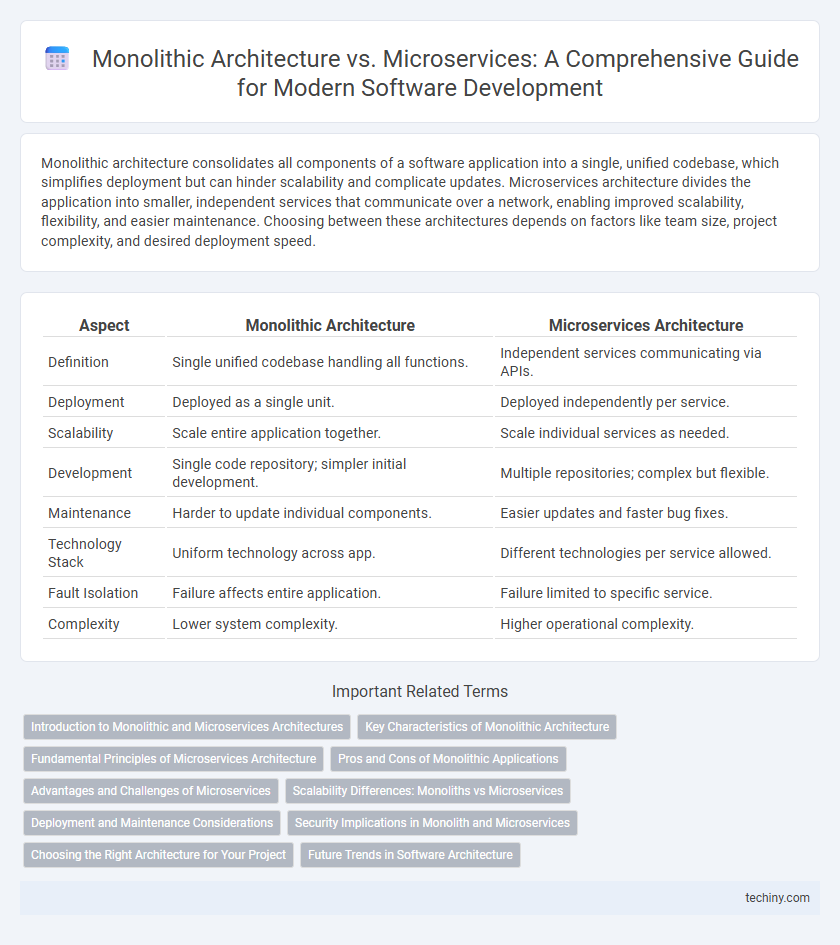Monolithic architecture consolidates all components of a software application into a single, unified codebase, which simplifies deployment but can hinder scalability and complicate updates. Microservices architecture divides the application into smaller, independent services that communicate over a network, enabling improved scalability, flexibility, and easier maintenance. Choosing between these architectures depends on factors like team size, project complexity, and desired deployment speed.
Table of Comparison
| Aspect | Monolithic Architecture | Microservices Architecture |
|---|---|---|
| Definition | Single unified codebase handling all functions. | Independent services communicating via APIs. |
| Deployment | Deployed as a single unit. | Deployed independently per service. |
| Scalability | Scale entire application together. | Scale individual services as needed. |
| Development | Single code repository; simpler initial development. | Multiple repositories; complex but flexible. |
| Maintenance | Harder to update individual components. | Easier updates and faster bug fixes. |
| Technology Stack | Uniform technology across app. | Different technologies per service allowed. |
| Fault Isolation | Failure affects entire application. | Failure limited to specific service. |
| Complexity | Lower system complexity. | Higher operational complexity. |
Introduction to Monolithic and Microservices Architectures
Monolithic architecture centralizes all components of a software application into a single, unified codebase, enabling simplified development but often leading to scalability challenges and complex maintenance. Microservices architecture decomposes applications into loosely coupled, independently deployable services, enhancing scalability, fault isolation, and technology diversity. The choice between monolithic and microservices architectures significantly impacts development speed, deployment flexibility, and system resilience in software development projects.
Key Characteristics of Monolithic Architecture
Monolithic architecture is characterized by a unified codebase where all components and functionalities are tightly integrated into a single application. It typically features centralized data management and shared resources that simplify deployment and testing processes. Scalability in monolithic systems often relies on vertical scaling, which can limit flexibility compared to distributed approaches.
Fundamental Principles of Microservices Architecture
Microservices architecture is defined by its fundamental principles of modularity, scalability, and decentralized data management, enabling independent deployment of services. Each microservice encapsulates a specific business functionality, communicating through lightweight protocols such as HTTP/REST or messaging queues. This approach contrasts with monolithic architecture by promoting fault isolation, continuous delivery, and the ability to use diverse programming languages and databases for different services.
Pros and Cons of Monolithic Applications
Monolithic architecture in software development offers simplicity in deployment and easier debugging due to its single unified codebase, which enhances performance efficiency and reduces latency. However, it faces challenges in scalability and flexibility, as changes in one component require redeployment of the entire application, potentially slowing down development cycles and increasing the risk of system-wide failures. This architecture suits smaller teams and projects but may struggle with maintainability and agility as the application grows in complexity.
Advantages and Challenges of Microservices
Microservices architecture offers advantages such as improved scalability, enabling independent deployment of services, and enhanced fault isolation which minimizes system downtime. It also supports technology diversity, allowing different teams to use the best tools for specific services. Challenges include increased complexity in service orchestration, the need for robust network communication, and difficulties with data consistency and transaction management across distributed services.
Scalability Differences: Monoliths vs Microservices
Monolithic architecture faces scalability challenges as the entire application must be scaled together, often leading to inefficient resource utilization and increased latency. Microservices architecture enables independent scaling of services based on demand, improving performance and optimizing resource allocation. This modular approach allows seamless horizontal scaling, making microservices ideal for dynamic, high-traffic environments.
Deployment and Maintenance Considerations
Monolithic architecture involves deploying a single, unified codebase, which simplifies initial deployment but complicates scaling and prolongs downtime during updates due to the need for full system redeployment. Microservices architecture enables independent deployment of discrete services, reducing downtime and increasing scalability by allowing targeted updates without affecting the entire system. Maintenance in monolithic systems often requires comprehensive testing across the entire codebase, while microservices demand robust coordination and monitoring tools to manage distributed services effectively.
Security Implications in Monolith and Microservices
Monolithic architecture centralizes application components, making security management more straightforward but increasing risks if vulnerabilities arise, as a breach can impact the entire system. Microservices distribute functionalities across independent services, enhancing isolation and limiting attack surfaces, but require robust API security, authentication, and inter-service communication protocols to prevent unauthorized access. Securing microservices involves managing complexities like encrypted data transmission, token-based authentication (e.g., OAuth), and continuous monitoring to address the dynamic nature of distributed systems.
Choosing the Right Architecture for Your Project
Choosing the right architecture for your software development project depends on factors such as scalability, deployment speed, and complexity management. Monolithic architecture offers simplicity and easier debugging for smaller, less complex applications, while microservices enable independent scaling, faster updates, and resilience for large, distributed systems. Evaluate project size, team expertise, and long-term maintenance requirements to determine whether a monolithic or microservices architecture best aligns with your development goals.
Future Trends in Software Architecture
Monolithic architecture, characterized by a single unified codebase, faces scalability and update challenges as applications grow, prompting a shift toward microservices which offer independent deployment and improved fault isolation. Future trends emphasize adopting hybrid architectures that combine monolithic stability with microservices' agility, leveraging containerization and orchestration tools like Kubernetes to enhance scalability and resilience. Increased use of AI-driven automation for monitoring and deployment is also transforming how software architectures evolve, enabling more efficient resource management and faster iteration cycles.
Monolithic Architecture vs Microservices Infographic

 techiny.com
techiny.com